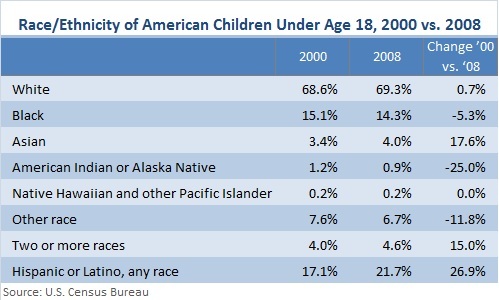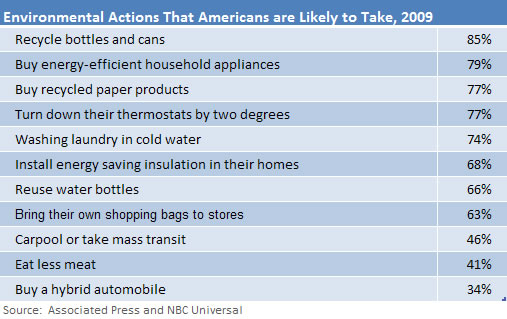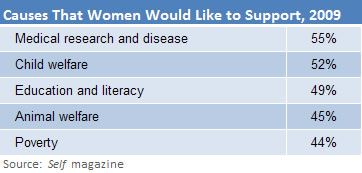Key Findings – March/April 2010
Race/Ethnicity of American Children
Latino children under age 18 are the fastest growing segment of the U.S. children’s population, up from 17.1% in 2000 to 21.7% in 2008.
The other groups increasing as a proportion of the U.S. population are White children (69.3% in 2009, up from 68.6% in 2000) and Asian children (4.0% in 2008, up from 3.4% in 2000). The following chart provides details on the change in population for other races/ethnicities.
Online Transaction Trends
Most Americans (84%) made at least one online transaction in 2009, including 68% who shopped online, 60% who handled their finances, 56% who booked travel, and 18% who bought insurance. Almost one-half (48%) conducted more online transactions than they did in 2008 because doing so allowed them to compare products and prices (72%), to take advantage of online-only sales (59%), and to save money on gas (45%).
However, the number of times they purchased something online in a typical month fell to 3.1, down from 3.4 in 2008 and 3.6 in 2007. They spent an age of $102 per shopping session in 2009, compared to $199 in 2008 and $130 in 2007.
More than one-quarter of shoppers who had trouble with an online transaction (26%) shared their experience with the company on its website (down from 32% in 2008), while 12% wrote about it on a social networking site or blog (up from 6% in 2008).
Defining Gentleman
According to GQ magazine, most men (62%) say they would like to be described as a gentleman, above being described as smart (16%), funny (14%), successful (4%), or handsome (3%). A majority of men define a gentleman as someone who is authentic and honest about who he is (82%), takes responsibility for his behavior (77%), and is confident but not arrogant (75%).
A Nickelodian TV report says 70% of parents think it’s important that they teach their sons to be respectful of women, 55% to be a good father, and 46% to be an independent thinker.
Teens and Tweens on Social Media
Internet users aged 15-17 spend 19.9 hours a week online for both personal use and schoolwork. Six in 10 (60%) consider themselves tech-savvy when compared to their peers, with 53% saying it’s important to “own the very latest in gadgets and technology.”
While 99% of Generation Y consumers (age 18-24) keep up an active profile on at least one social network, only 22% of this age group use Twitter, according to a report by Participatory Marketing Network. Of those using Twitter, most (85%) follow friends, 54% follow celebrities, and 29% follow companies.
Environmental Actions
One third of Americans (32%) say they have thought hard about their personal impact on the environment, compared to 37% who have thought little about it. The following chart shows which actions they are likely to take.
Cause Marketing and Women
Some 62% of women shoppers (ages 18-49) feel they are making the world a better place by supporting brands that engage in socially responsible efforts, with 54% saying those purchases make them feel they are living their values.
Almost all women (93%) supported at least one cause in 2009. Seventy-three percent say they are willing to pay more for products to help companies off-set their “do good” efforts.
In 2007, research showed that women responded well to the words socially responsible, ethical and informed. However, in 2009, they preferred words such as caring, generous and unselfish.
Attitudes on Advertising
Six in ten Americans (61%) have an opinion about advertising that references the recession. Some 44% say it makes the ads seem more manipulative, 38% say it makes the brands seem more realistic, and 20% say those ads depress them and make them less likely to purchase the brand. The chart below breaks this down by age group.

Paying for Online News Sources
One in seven Americans (15%) currently pays to access news online. They fall into these three paying categories equally: $1-5 per month (5%), $6-10 per month (5%), and more than $10 per month (5%).
American’s current sources of news are primarily free: 65% get news from broadcast TV, 51% from online portals, 50% from TV station websites, and 35% from the radio. Most (56%) get news from cable news channels, 36% use local or regional newspapers, and 30% subscribe to national newspapers.
Some 48% of Americans are willing to pay for online news. The following chart breaks down the amounts they are willing to spend.
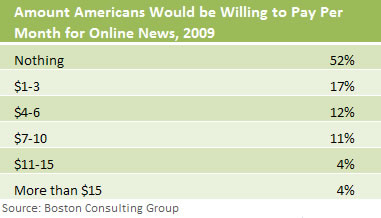
How Americans Define Wellness
Americans’ definition of wellness has shifted significantly since 2008. While they used to say it’s about being fit, healthy, and leading a balanced life, the new view focuses on re-inventing their lives. The following chart provides a closer look at this change in attitudes.
Connectivity Is Important
A 2009 Motorola study found that most Americans (78%) feel as though they are constantly connected to friends, family, and colleages, regardless of their physicial location. A majority in each generation says that being connected is a necessity to them: Millenials (79%), Gen Xers (64%), and Baby Boomers (65%).
When they are connected, they feel relaxed (68%), confident (62%), peaceful (55%) and proud (32%). When they aren’t connected, they feel frustrated (66%), stressed (47%), anxious (43%) angry (32%), disorganized (31%) and outdated (22%).
Adult Depression
Most American adults who suffer from depression (57%) receive care from their primary physician, while 38% see a mental health professional. Two-thirds (67%) use medication for treatment, with 62% of those saying it has been very helpful. Some 19% have used animal therapy, with 54% reporting it as being very helpful. Overall, only 35% of depression patients report being very happy with the overall treatment they are receiving for their condition.
Those with depression typically open up to their family and health professionals but conceal it from others. See the chart below for details.
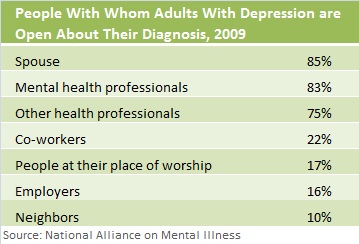
B2B Digital Budget Forecast
Typically, business-to-business marketers spend over one-half of their digital budgets on their Web sites, which is expected to grow 7.5% in 2010. Search engine marketing, which accounts for 15% of budgets, will grow 17%. Webinar related expenditures will rise 26%, video sites approximately 153%, and social networking 43%.
According to Outsell, business-to-business firms plan to cut their mobile marketing spending by 38% in 2010. From 2008 to 2009, their mobile spending had grown 5%.
Digital marketing expenditures by all U.S. advertisers will surpass those of print for the first time during 2010. Print spending will about 3.2%, while online spending is expected to grow almost 10%.
Workplace Favoritism
Almost four in 10 employees (38%) say there is departmental favoritism at their workplace, according to CareerBuilder. Sales departments (15%) get the most preferential treatment, followed by human resources (11%) and accounting/finance (6%).
The following chart shows which factors influence employees’ concerns.

Family Business
According to a study by MassMutual, owners of family businesses say they enjoy several benefits from starting and running their own company. The list includes:
However, they also report the following problems with this arrangement:
Family business owners report that the most trusted person in the business is their spouse. However, they mostly look to others for business advice such as accountants (55%), and lawyers (43%) before they turn to their spouses (43%).

